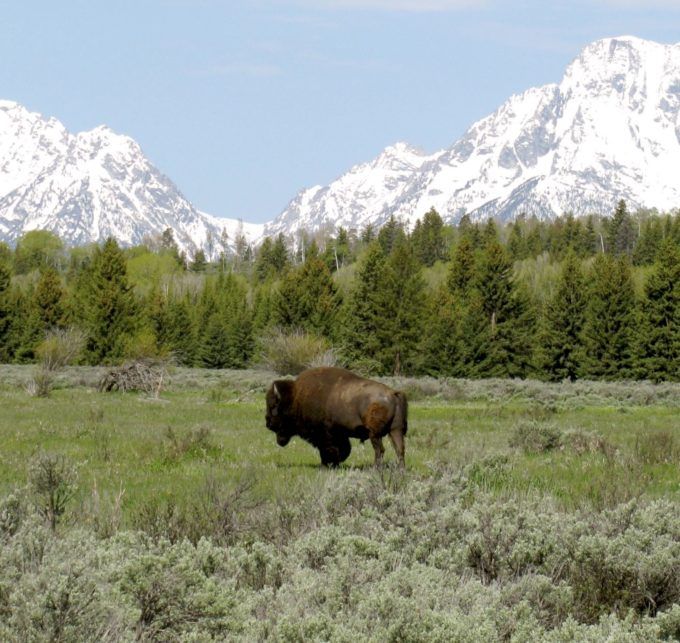

Wild bison, Grand Teton National Park. Photo: Jeffrey St. Clair.
Recently news media announced the transfer of 141 of Yellowstone’s bison to the Fort Peck Indian Reservation. Most of the media and many conservation groups hailed this as “restoring” bison to the plains. What is not said is that this transfer to the tribe, and all other previous transfers are destroying the wild bison genome.
The second issue is the failure of the federal government to protect it Public Trust obligations. Yellowstone’s bison belong (if one can suggest wildlife belongs to anyone) to the American people. Yet they are being privatized when given to tribal reservations.
Yellowstone’s bison are of international significance in part because they have been the least domesticated buffalo in the West. They are an evolutionary heritage that is priceless.
They have been subject to native predators, harsh winters, droughts, had natural selection in breeding and free to migrate—until they reach the border of the Park.
Domestication is the biggest threat to wild bison. And nearly all government and private policies are eroding the wild bison genome.
The bison transferred to Fort Peck Indian Reservation will be held in a 13,000 acre “ranch”. Since 2019, the Yellowstone Bison Conservation Transfer Program has transferred 414 bison to Fort Peck. A record 116 animals were transferred this February: 108 males, four females and four calves. The tribe offers canned bison hunts.
These animals are likely to be artificially fed; perhaps selectively bred and killed, disrupting natural population dynamics. Since they will be held in a small enclosure (13,000 acres is nothing to a bison) they may lose the tendency to migrate which is perhaps their greatest evolutionary adaptation to an unpredictable environment.
All these non-Yellowstone herds are too small to avoid inbreeding depression and random genetic losses.
In short, on-going bison transfers and slaughter of bison at the park border will continue the erosion of Yellowstone bison wildness and they will be domesticated.
Though proclaiming bison transfers are “saving” bison is like promoting fish hatcheries and asserting we are “saving” wild salmon. In fact, numerous studies have documented that hatchery production is contributing to the decline of wild fish.
However, when bison are transferred to Indian reservations or killed on the border of the park, this removes the buffalo biomass from the ecosystem. By reducing bison population within the park, it lessens competition for forage and allows the remaining bison to be less vulnerable to predators or dying from such influences as starvation.
This in turn harms the scavengers like magpie, ravens, eagles, wolves’ grizzly bears and coyotes.
Due to the Supremacy Clause of the Constitution, the Federal government is not obliged to adhere to the state’s prohibition against restoration of bison on public land in Montana. The federal government can legally promote migration of wild bison to the Custer Gallatin NR and other federal holdings around Yellowstone. Indeed its Public Trust obligation means it should override state objections.
If there are “excess” Yellowstone bison, at the very least they should be transferred to public lands, not privatized. Establishing several other “wild” herds will preclude the loss of this genome if there were a disease outbreak or some other factor contributed to the loss of Yellowstone’s bison herds.
The Charles M. Russell Wildlife Refuge, and adjacent BLM lands like the Missouri River Breaks NM offers a superb opportunity to establish another free-ranging bison herd. There are other lands in Wyoming and Idaho that are also suitable for bison recolonization like the Red Desert, Upper Green River, and Birch Creek/INL lands in Idaho.
Wild bison deserve a better future than being turned into domesticated livestock. We don’t have to accept the current policies. We can demand that Yellowstone bison be permitted to migrate beyond Yellowstone borders without being slaughtered, as well as establishing several other large conservation herds that are subject to evolutionary processes and avoid the continuing slide towards domesticated animals.
The post Domestication is the Greatest Threat to Wild Bison appeared first on CounterPunch.org.
This post was originally published on CounterPunch.org.

